Physical Address
304 North Cardinal St.
Dorchester Center, MA 02124
The relationship between function and structure of the skin is best demonstrated by presenting diseases that illustrate how skin can fail. Thus, disease reveals function, and function illustrates structure
The most obvious function of skin is to maintain an internal environment that allows an organism to protect DNA and to reproduce it relatively faithfully
Cutaneous structures include an epidermis that serves as a barrier (preventing loss from within as well as damage from external insults) and a dermis that provides circulation and nutrition. Other functions provided by the cells that reside within the skin include immune recognition and memory, a capacity to repair damage, thermoregulation, and communication
Evidence that skin has failed may be found in barrier disruption, infection, autoimmunity, cancer, and an undesirable appearance
Most reviews of the anatomy and physiology of skin begin with detailed descriptions of cellular composition, structural proteins, and extracellular matrix (“ground substance”). Because each of these subjects, with relevant documentation, is presented in subsequent sections of the textbook, these aspects of cutaneous function will be introduced only briefly, using references to appropriate chapters. Following this, the conventional approach is reversed by examining diseases that illustrate cutaneous function in the context of the cells and structures that sustain it. This method is derived from the assertion that the structure and function of skin is revealed best through disease. The validity of this alternative methodology may be seen in clinical vignettes easily recognized by those who care for patients with skin disease:
a young man with oculocutaneous albinism from Central Africa develops multiple squamous cell carcinomas (SCCs) before the age of 25
a 16-year-old boy with hypohidrotic ectodermal dysplasia suffers heat stroke while competing in outdoor athletics in Texas
toxic epidermal necrolysis due to phenytoin develops in a 40-year-old woman, leading to dehydration and sepsis
numerous SCCs arise on the face and extensor forearms of a renal transplant recipient who continues to work outdoors
linear eruption of grouped vesicles due to varicella–zoster virus develops on the left flank of an otherwise healthy young man
These patients and their diseases illustrate at least four of the functions of skin: photoprotection, thermoregulation, barrier formation, and immunologic protection. Each function is supported by the cells and structural elements that reside there.
Consistent with conventional introductory chapters on cutaneous structure and function, we begin with a schematic representation of a section through normal skin ( Fig. 1.1 ). The anatomic structures observed by light microscopy are fairly similar in most regions of the body ( Fig. 1.2 ). However, specialized regions of skin, including the palms, soles, genitalia and scalp, have modified forms that address regional functional requirements ( Fig. 1.3 ).
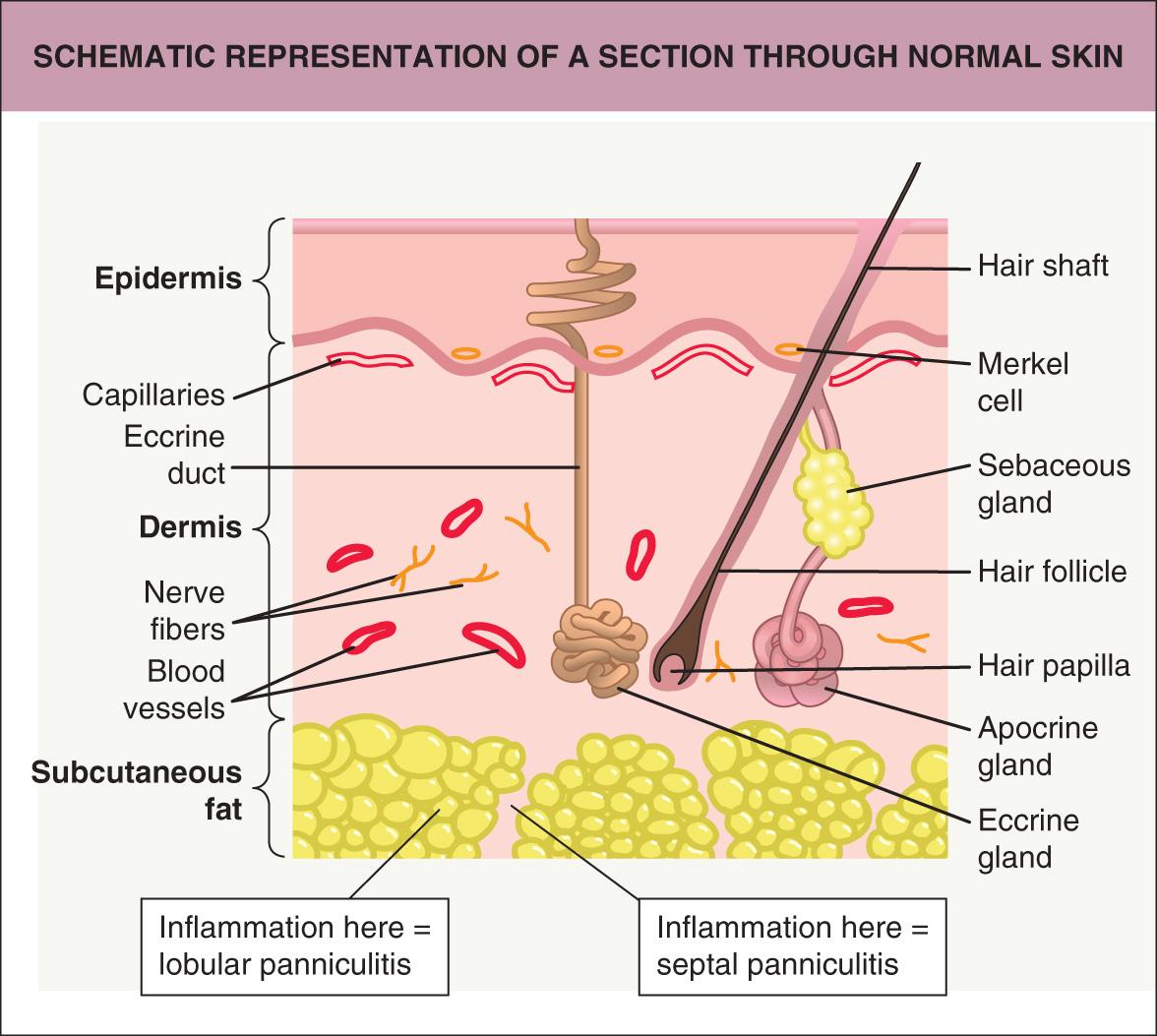
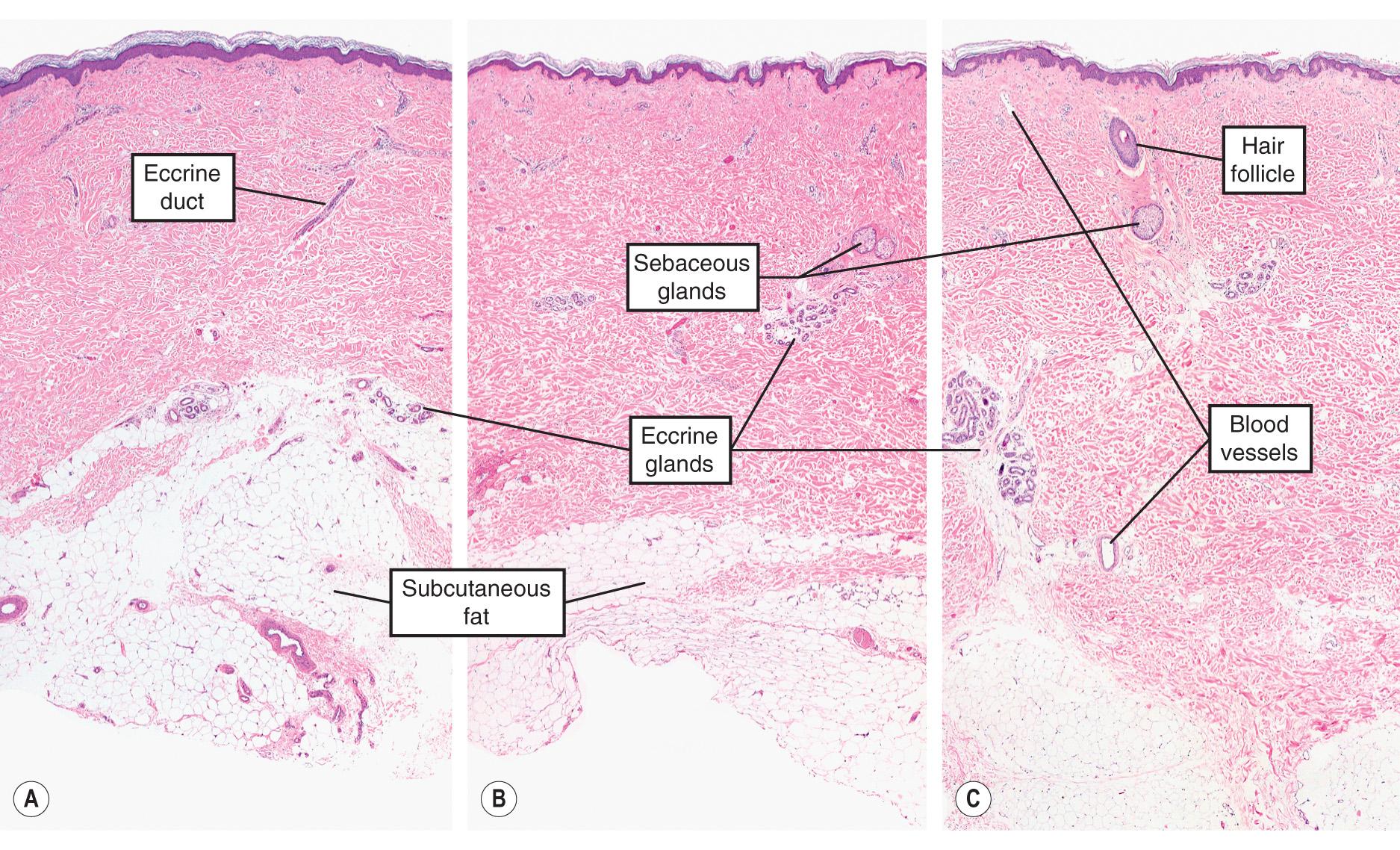
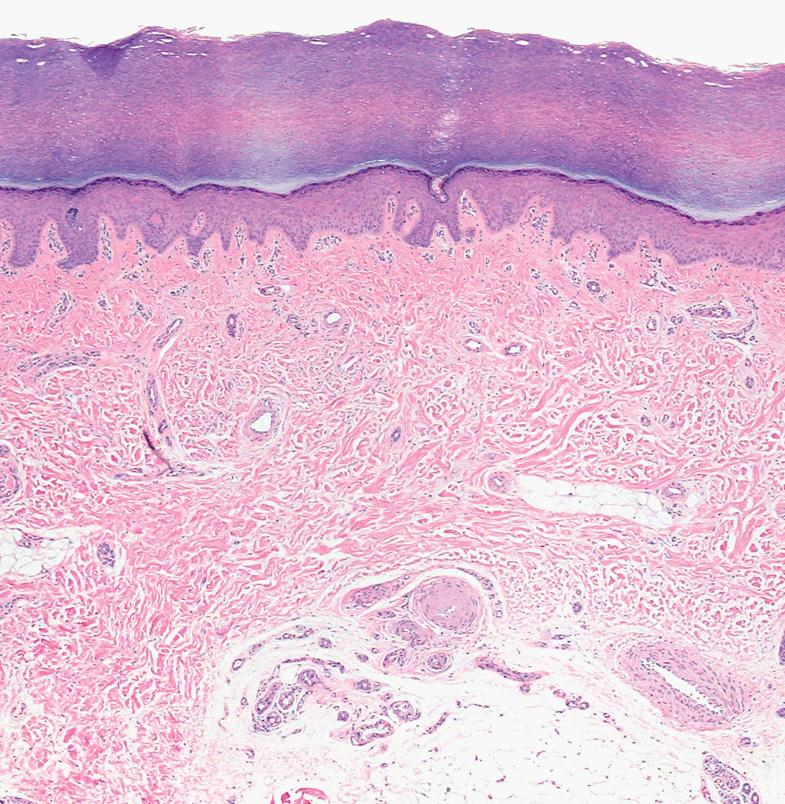
As seen in Fig. 1.2 , the outer layer of skin (epidermis) consists of a thin matrix of cells. In humans, the epidermis contains four major resident populations: keratinocytes ( Ch. 56 ), melanocytes ( Ch. 65 ), Langerhans cells ( Ch. 4 ), and Merkel cells ( Chs 2 & 115 ) . Keratinocytes , the major population, originate in a stem-cell pool situated in the basal layer; cells that leave this pool then undergo maturation as they migrate upward, ultimately forming the laminated stratum corneum ( Fig. 1.4 ). The human epidermis averages 50 microns in thickness, with a surface density of approximately 50 000 nucleated cells/mm 2 . Under basal conditions, differentiated keratinocytes require about two weeks to exit the nucleated compartment and an additional two weeks to move through the stratum corneum . It should be noted that keratinocytes have the capacity to increase rates of proliferation and maturation to levels far greater than this, when stimulated to do so by injury, inflammation or disease ( Ch. 8 ).
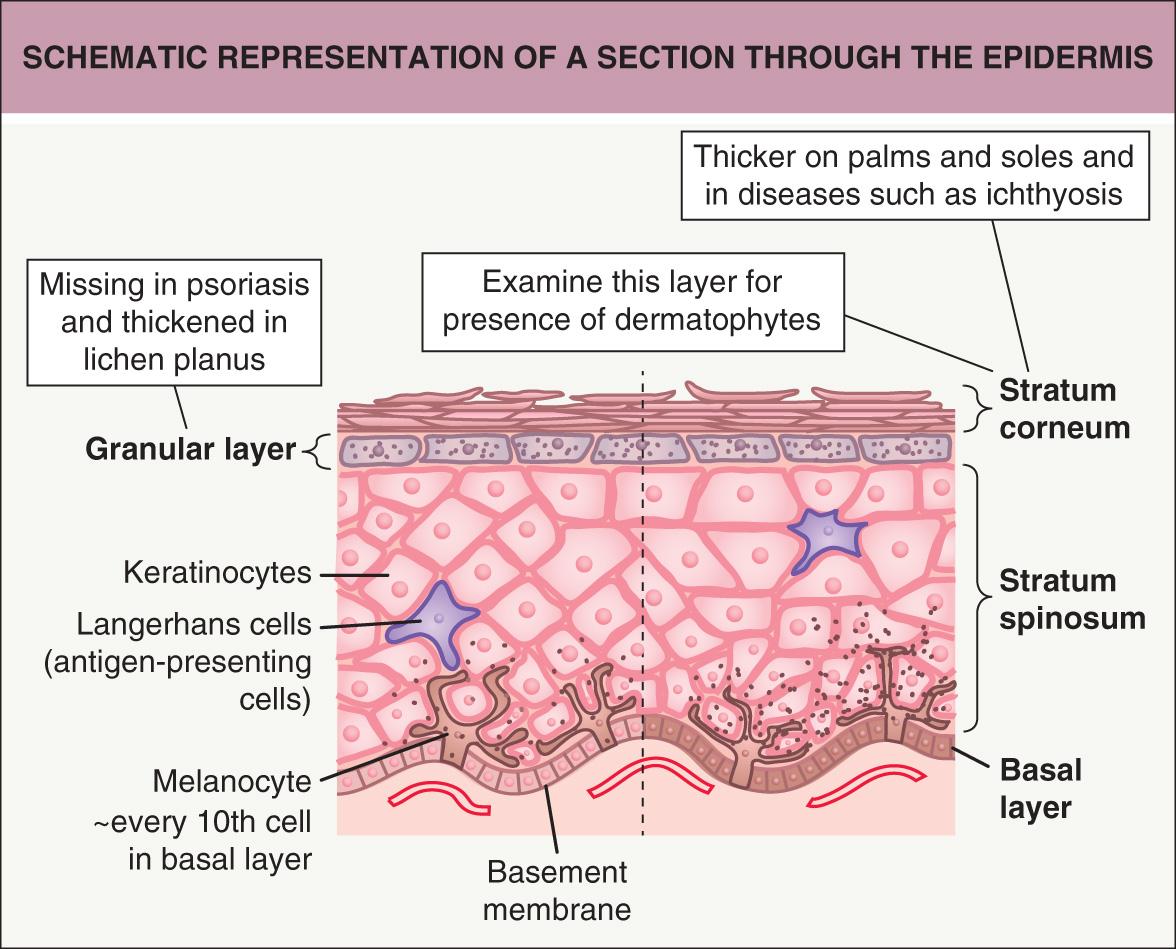
Melanocytes , as noted in a DOPA-stained whole mount of epidermis (see Fig. 65.6 ), have the capacity to elaborate the light-absorbing pigment melanin, which plays a major role in protecting the skin from UV radiation ( Ch. 86 ). Melanosomes, with their complement of melanin, are produced by melanocytes and then transferred by excretion and phagocytosis into nearby keratinocytes, where they assume their preferred location above the nucleus (see Fig. 65.5 ) .
Members of the third major resident epidermal population, Langerhans cells , have the capacity to metabolize complex antigenic materials into peptides, some of which are immunogenic (see Fig. 4.4 ). After activation, these cells traffic out of the epidermis toward regional lymph nodes, where they play a critical role in antigen presentation during the induction and regulation of immunity (see Fig. 4.14 ).
Merkel cells , which contain neuroendocrine peptides within intracytoplasmic granules, are also found in the basal layer of the epidermis, although they may not be apparent in routine histologic sections. Over the past decade, there have been advances regarding their origin and pathology ( Chs 2 & 115 ) .
The most obvious function of epidermis lies in the stratum corneum (see Fig. 1.4 ), the semipermeable laminated surface aggregate of differentiated (keratinized) squamous epithelial cells, which serve as a physiologic barrier to chemical penetration and microbiologic invasion from the environment, as well as a barrier to fluid and solute loss from within ( Ch. 124 ).
Beneath the epidermis, a vascularized dermis provides structural and nutritional support. It is composed of a glycosaminoglycan gel held together by a collagen- and elastin-containing fibrous matrix ( Fig. 1.5 ) ( Ch. 95 ). Vascular structures, accompanied by nerves and mast cells ( Ch. 118 ), course through the dermis to provide nutrition, recirculating cells, and cutaneous sensation. Three additional cells, fibroblasts, macrophages and dermal dendritic cells, complete the list of dermal residents. In pathologic conditions such as acute inflammation, the functions and types of dermal cells change substantially, with a variety of infiltrating leukocytes arriving via vascular routes. In fact, the composition of cutaneous infiltrates differs depending on the disease entity, which provides students of dermatopathology useful diagnostic clues ( Fig. 1.6 ).
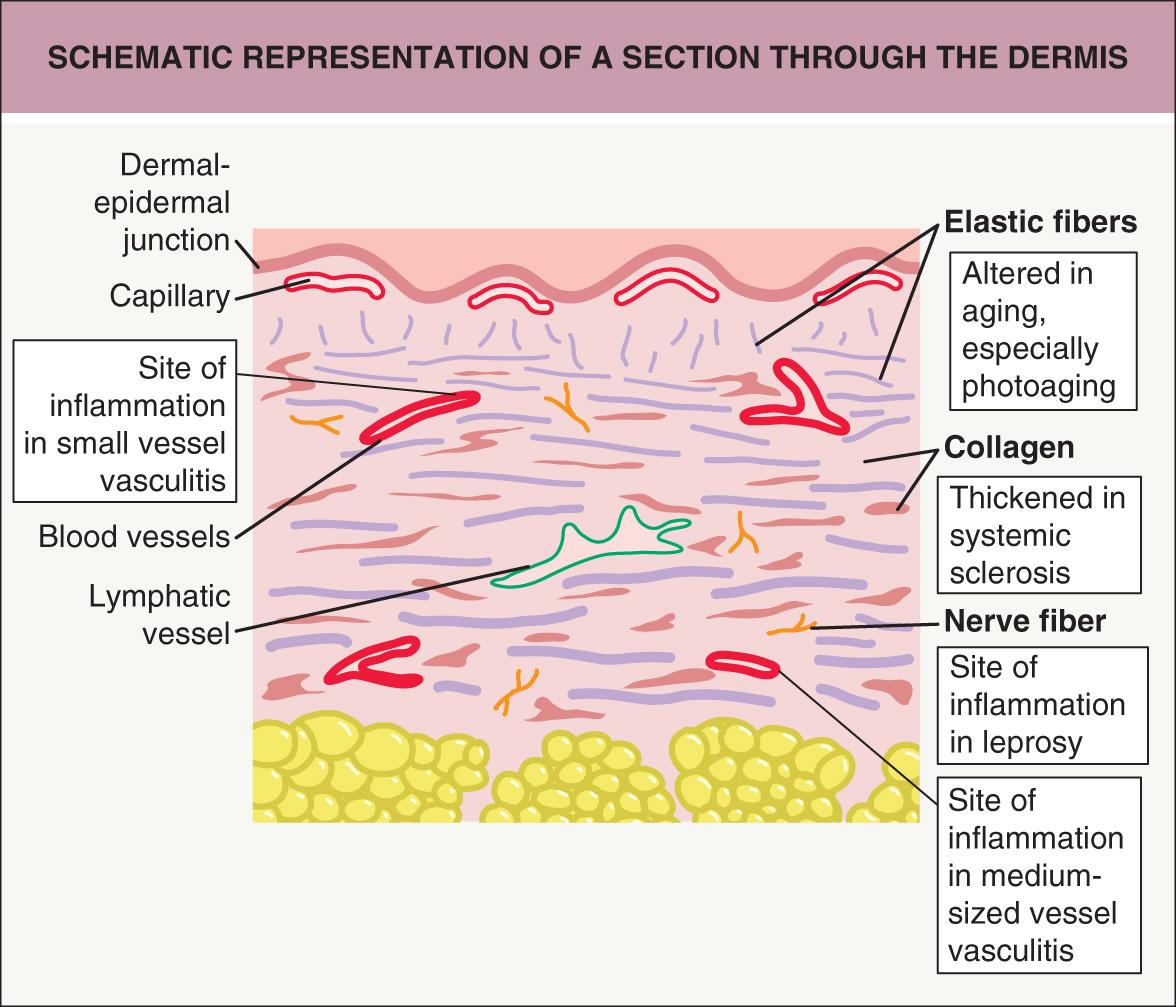
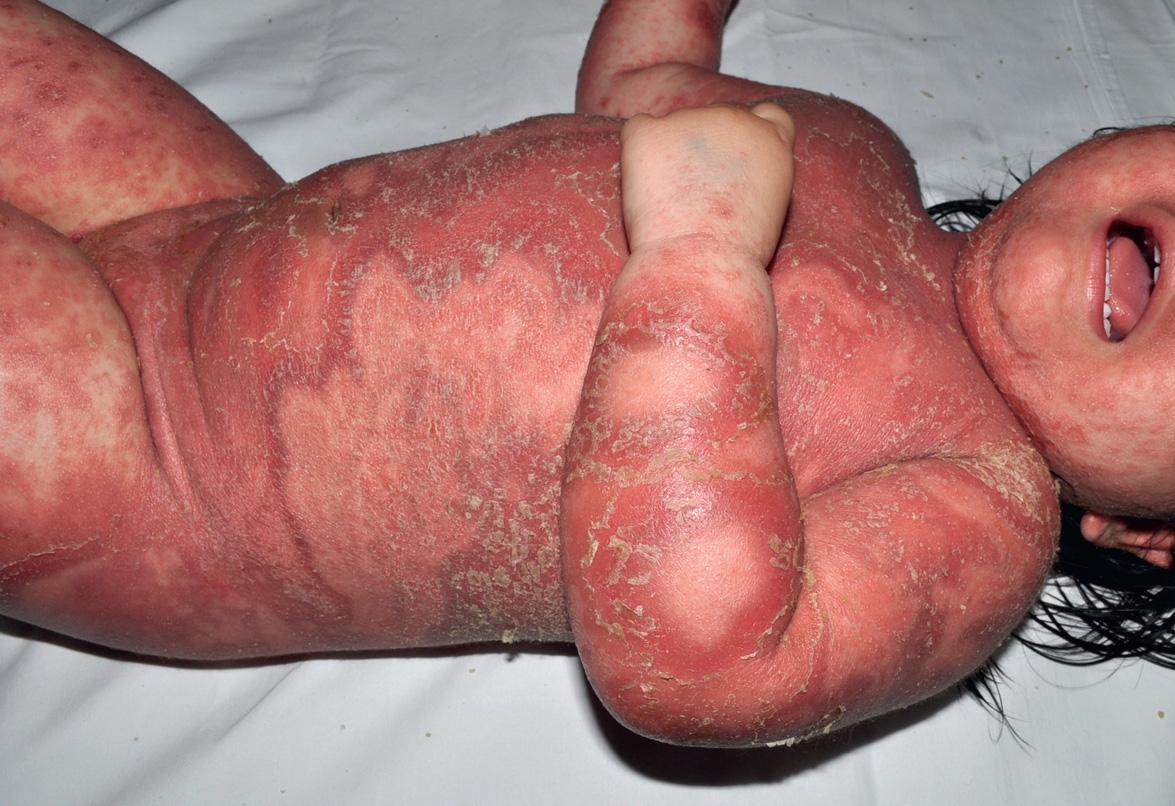
The boundary between epidermis and dermis consists of a specialized aggregation of attachment molecules, collectively known as the basement membrane ( Ch. 28 ). This structure is of considerable interest, because a variety of diseases originate from genetic defects in its composition; it also may serve as a target of autoimmune attack.
We have chosen to present in the remainder of this chapter a conceptual framework into which the other chapters of this textbook may be placed. This framework is derived from the assertion that knowledge of cutaneous function begins with disease. One corollary of this assertion is that there may be unrecognized functions of skin, either because there is no corresponding disease or because the disease is fatal. For example, no one would have guessed that incontinentia pigmenti was lethal in males had it not been for the survival of heterozygous females with this X chromosome-linked disease . Overwhelming apoptosis is thought to explain the death of male fetuses in utero .
Two other prejudices color the picture we choose to paint. First, we deviate from the concept that physicians should invariably attempt to develop a single diagnosis for an illness. Rather, we believe that it is possible and even likely that two or more disease processes and/or predispositions may underlie an illness and that such simultaneous occurrences may alter the clinical presentation. In fact, practicing dermatologists are quite aware of the unusual morphologic features of pityriasis rosea when it occurs in a patient with underlying psoriasis or when a patient with atopic dermatitis improves substantially following treatment with an antibiotic, even in the absence of obvious infection. A growing array of genetic factors and infectious agents are known to modulate the course of otherwise conventional skin diseases. Witness the presence of numerous viral warts or tumors of molluscum contagiosum in patients with immunodeficiency from occult HIV infection or from iatrogenic immunosuppression. Thus, dermatologists have an extra assignment: to find otherwise hidden genetic, infectious and environmental factors that modify the appearance and severity of cutaneous disease.
All plants and animals possess limiting membranes that define an internal space and at the same time protect against insults. In mammals, these membranes, which may be described functionally as “barriers”, occur primarily in three organs: the lung, gastrointestinal tract, and skin ( Ch. 124 ). Although similar in concept, the barrier properties of these organs are fundamentally different. Pulmonary and gastrointestinal barriers, by virtue of their internal location, are protected from many environmental influences, and at the same time they promote rather than retard the transfer of gases, nutrients, and wastes. By contrast, and with the possible exception of UV radiation-facilitated vitamin D 3 production , there is no obvious benefit to skin penetration, or, at least, there are as yet no recognized diseases attributed to the failure of any material or form of energy to penetrate the skin. It should be noted, however, that biomedical scientists now try to subvert the cutaneous barrier, as skin has become a target of novel therapies based upon percutaneous penetration ( Chapter 124, Chapter 125, Chapter 126, Chapter 127, Chapter 128, Chapter 129 ). In addition to serving as a useful portal of entry for pharmaceutical agents, there is the possibility of the skin serving as a site for immunization with gene-based materials and as a gene-driven cutaneous factory .
Although we begin with the common rhetorical question: “What are the functions of skin?”, it is followed by a more complicated question: “What are the requirements of skin that allow it to serve those functions?”. We propose that the primary function of skin is to maintain an internal environment that allows an organism to protect DNA and to reproduce it relatively faithfully. In short, preservation and reproduction of DNA sustains the species. A second and highly related process in a changing world is the generation of useful changes in DNA that accommodate new environmental circumstances. Evolution of the species subsequently ensues as an adaptation. For example, skin pigmentation improves reproductive success in tropical climes by protecting folate from UV-mediated degradation, while lightly pigmented skin is advantageous for vitamin D biosynthesis in areas where UV radiation is scarce .
Although the permanent repository of DNA lies in the gonads, the protection of DNA in all sites, including the skin, is also essential for biologic success. This concept of the centrality of DNA has been developed by Reg Morrison in his monograph The Spirit in the Gene: Humanity's Proud Illusion and the Laws of Nature , which reviews how life-form competition may be modeled as a method of protecting DNA . Morrison makes the striking observation that human DNA has in the last 300 years come to dominate all life on earth.
So, what are the requirements of skin in order to protect and replicate DNA? In fact, these requirements have not been identified through logical considerations; rather, as noted above, they have been identified through the various failures that eventuate in skin disease. For this reason, we begin our survey with a listing of failures of skin ( Table 1.1 ).
| SELECTED REQUIREMENTS AND FAILINGS OF SKIN | |
|---|---|
| Requirement | Selected failings |
| Prevent infection via innate and adaptive immunity | Fungal, bacterial and viral infections; autoimmunity, cancer |
| Maintain a barrier | Infection, dehydration |
| Repair injury | Cancer, leg ulcers |
| Provide circulation | Infarction (due to embolization, vasculitis, or other forms of occlusion) |
| Communicate | Sensory neuropathy, pruritus |
| Provide nutrition | Vitamin D deficiency |
| Regulate temperature | Hypothermia, hyperthermia |
| Attract attention | Photoaging, vitiligo, alopecia |
An intricate system of immunologic recognition, both innate and adaptive, protects skin (and underlying tissues) from infection ( Ch. 4 ). The cornerstone of adaptive immunity lies in recirculating lymphocytes and antibodies that are specifically recruited and “tuned” to recognize “foreign” materials, primarily peptides derived from infectious agents. Initial recognition occurs when sentinel dendritic cells in the epidermis (Langerhans cells) and dermis (dermal dendritic cells) are activated. Prior to activation, these cells acquire the capacity to engulf particles of many sizes and to metabolize complex proteins into small immunogenic fragments. Once activated, motility is induced, allowing these cells to travel out of their cutaneous residence, and, via draining lymphatics, move to regional lymph nodes. Thus, these residents of normal skin have the capacity to travel to a distant location where reactive lymphocytes are selected and then expanded greatly in number. Within a lymph node, activated T helper lymphocytes assist B lymphocytes to generate antibodies, while T helper lymphocytes and cytotoxic T lymphocytes begin to recirculate preferentially to and from skin. A population of effector memory T lymphocytes resident within the skin has also been identified, and these cells play a critical role in immune responses .
The diagnosis and treatment of infection constitutes a substantial portion of dermatology ( Chapter 74, Chapter 75, Chapter 76, Chapter 77, Chapter 78, Chapter 79, Chapter 80, Chapter 81, Chapter 82, Chapter 83 ). Examples of chronic and recurrent infectious skin diseases illustrate the extent to which mechanisms of resistance to infection are lost or defective in some patients. In examples that follow, initial resistance depends upon the structural integrity of the stratum corneum.
Trauma to the stratum corneum interrupts a physical barrier that is ordinarily not susceptible to viral infection ( Ch. 79 ). In addition, trauma allows implantation of infectious particles among the underlying keratinocytes, which are viable and less resistant. Following this structural failure, immunologic recognition of infected keratinocytes is ordinarily followed by a cytotoxic cellular response, destruction, and cure. When this fails, chronic infection may ensue ( Fig. 1.7 ). It is of interest that many therapies for warts, other than physical destruction, rely on modulating the immune response. On the other hand, few problems are more vexing than chronic and recurrent warts, particularly in patients who are immunosuppressed. Especially important are the viral serotypes associated with SCC and the genetic disorder epidermodysplasia verruciformis ( Ch. 79 ). It is instructive that protective immunity against warts often appears to be balanced precariously, so that minor shifts in responsiveness may lead to their elimination in many sites simultaneously. This has been attempted therapeutically by the use of oral cimetidine, topical applications of imiquimod, elicitation of contact sensitivity reactions, and intralesional injection of recall antigens such as Candida or mumps .
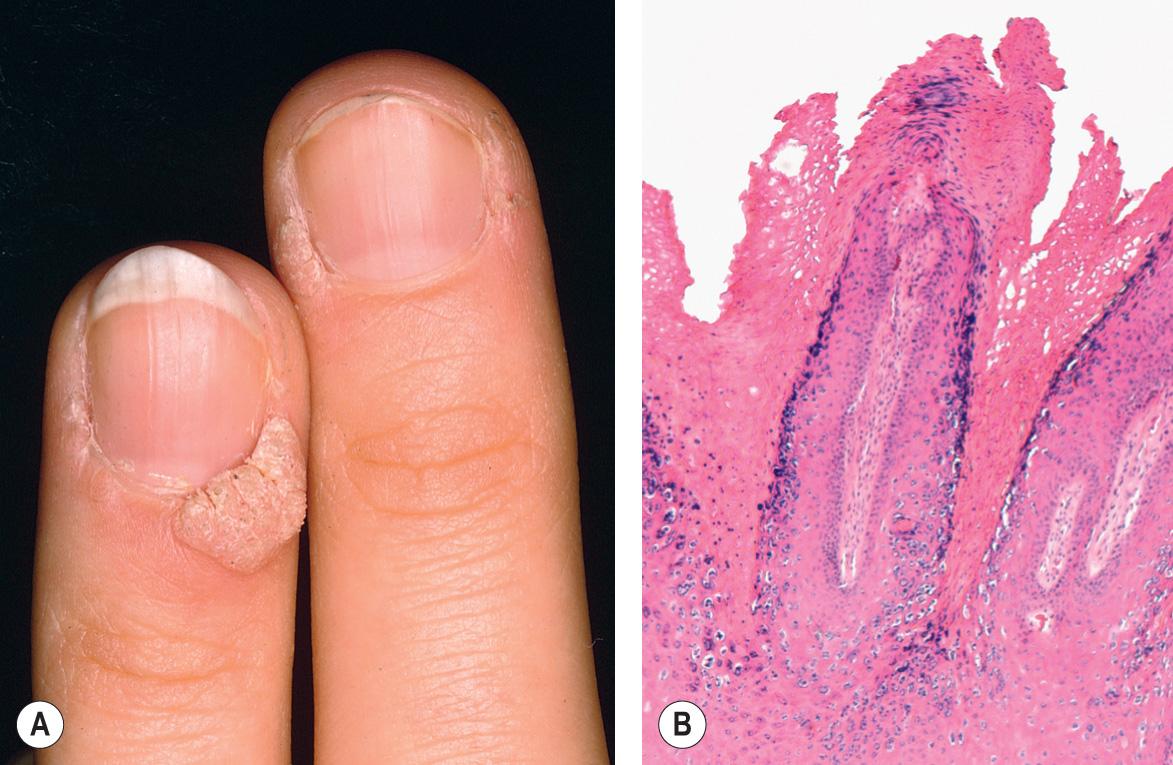
The diagnosis and treatment of infections with dermatophytes remain largely the responsibility of dermatologists ( Ch. 77 ). Perhaps this is because dermatophyte infections are almost invariably limited to the skin, hair and nails, inasmuch as one or more serum factors (e.g. transferrin) may prevent growth where serum can reach . As yet unidentified genetic factors protect some individuals from infection, because it is not uncommon to encounter families in which several individuals are chronically infected, whereas other family members, in the face of obvious exposure, are seemingly never infected. On the other hand, experience from tropical climates indicates that individuals who are relatively resistant in a dry environment may lose that resistance as the ambient humidity increases or when occlusive military shoes are worn . Obviously, dermatophyte infection and resistance include a complicated interplay among genetic susceptibilities, immune responsiveness, and environmental circumstances.
An enormous body of biomedical knowledge has accrued during the 35-year epidemic of HIV infection ( Ch. 78 ). As a beginning, it appears that HIV penetrates through small tears in genital and rectal mucosae. Once infection has occurred, the virus has been impossible to completely delete, despite a panoply of relatively effective therapies. With loss of immunologic integrity, patients develop AIDS and thereby demonstrate the relevance of effective cellular immunity to protection against infections with a wide variety of agents, including Mycobacterium tuberculosis, Pneumocystis jirovecii , varicella–zoster ( Fig. 1.8 ), and herpes simplex viruses. What more evidence would one want to demonstrate the relevance of cellular immune protection of skin than the diseases that are described in Chapter 78 ?
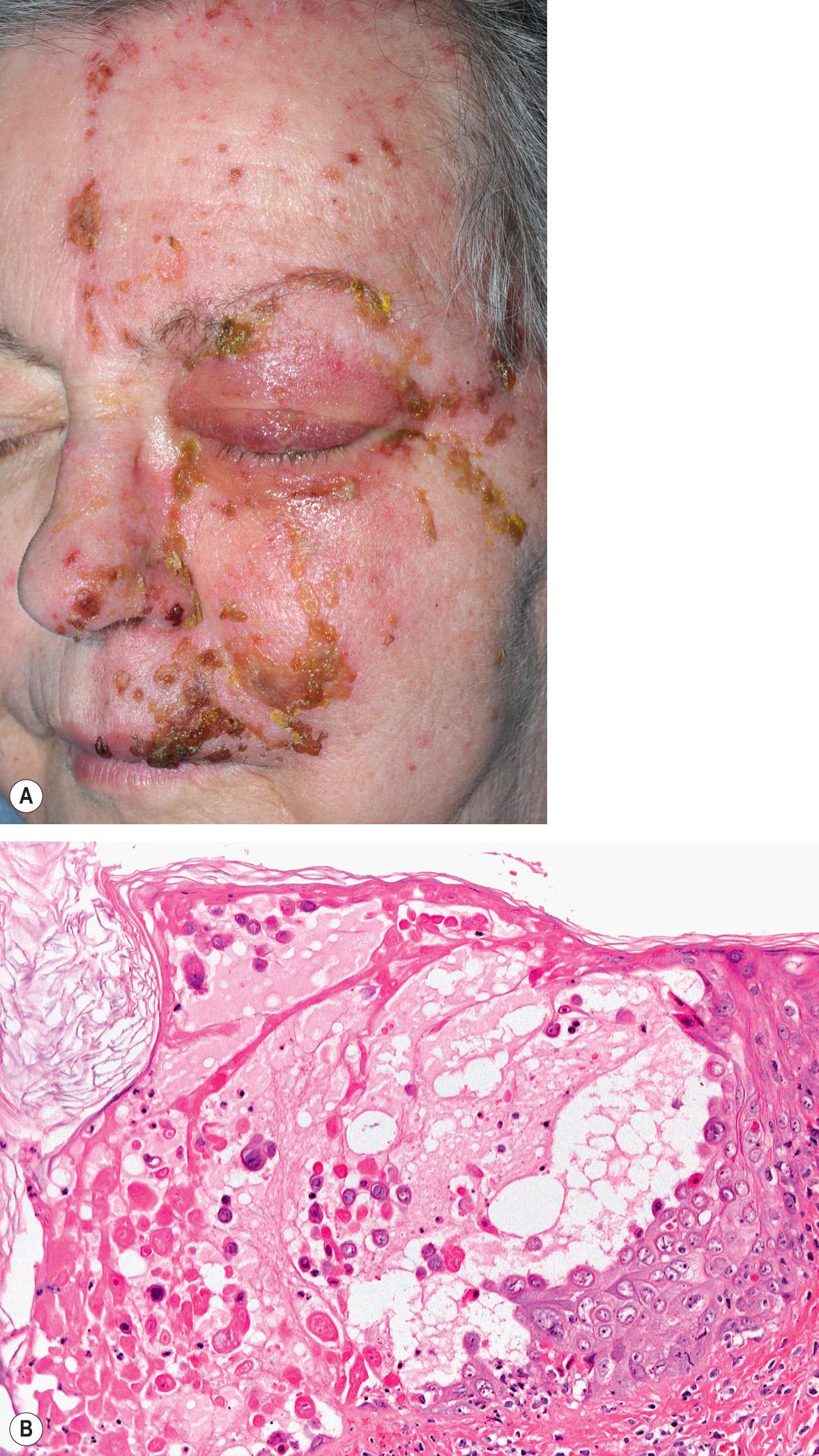
Leprosy is instructive in that the majority of humans exposed to its causative organism, Mycobacterium leprae , develop an effective immune response that is seemingly curative ( Ch. 75 ). On the other hand, a small percentage of exposed individuals develop chronic infection that may take any one of several forms, based on immunologic resistance. In fact, observations made in patients with leprosy have been important in formulating the Th1/Th2 paradigm ( Ch. 4 ), with each patient's clinical response falling along a spectrum from tuberculoid to lepromatous . Importantly, leprosy also illustrates the relevance of cutaneous sensation to protection against traumatic injury, as will be presented later.
Warts, dermatophytosis, opportunistic infections in the setting of HIV infection, and leprosy all illustrate important aspects of cutaneous function, ranging from a structural barrier provided by the stratum corneum to immunologic recognition and protective immunity.
We have made a case for the concept that the primary task of immunity is to recognize and destroy infectious organisms. Having stated this, autoimmunity may then be modeled as a failure in distinguishing “self” from infection, i.e. autoimmunity is a misidentification and destruction of portions of the host, as if it were dangerous or “foreign”. Autoimmune diseases are legion, with components of the epidermal basement membrane and desmosomes serving as important targets ( Fig. 1.9 ). Moreover, cutaneous cellular elements serve as both regulators and targets of autoimmune injury. Table 1.2 lists several common autoimmune diseases that affect the skin, each with a different target. These diseases have different sets of genetic factors and environmental insults that promote their development. Subsequent chapters detail their relevant elements.
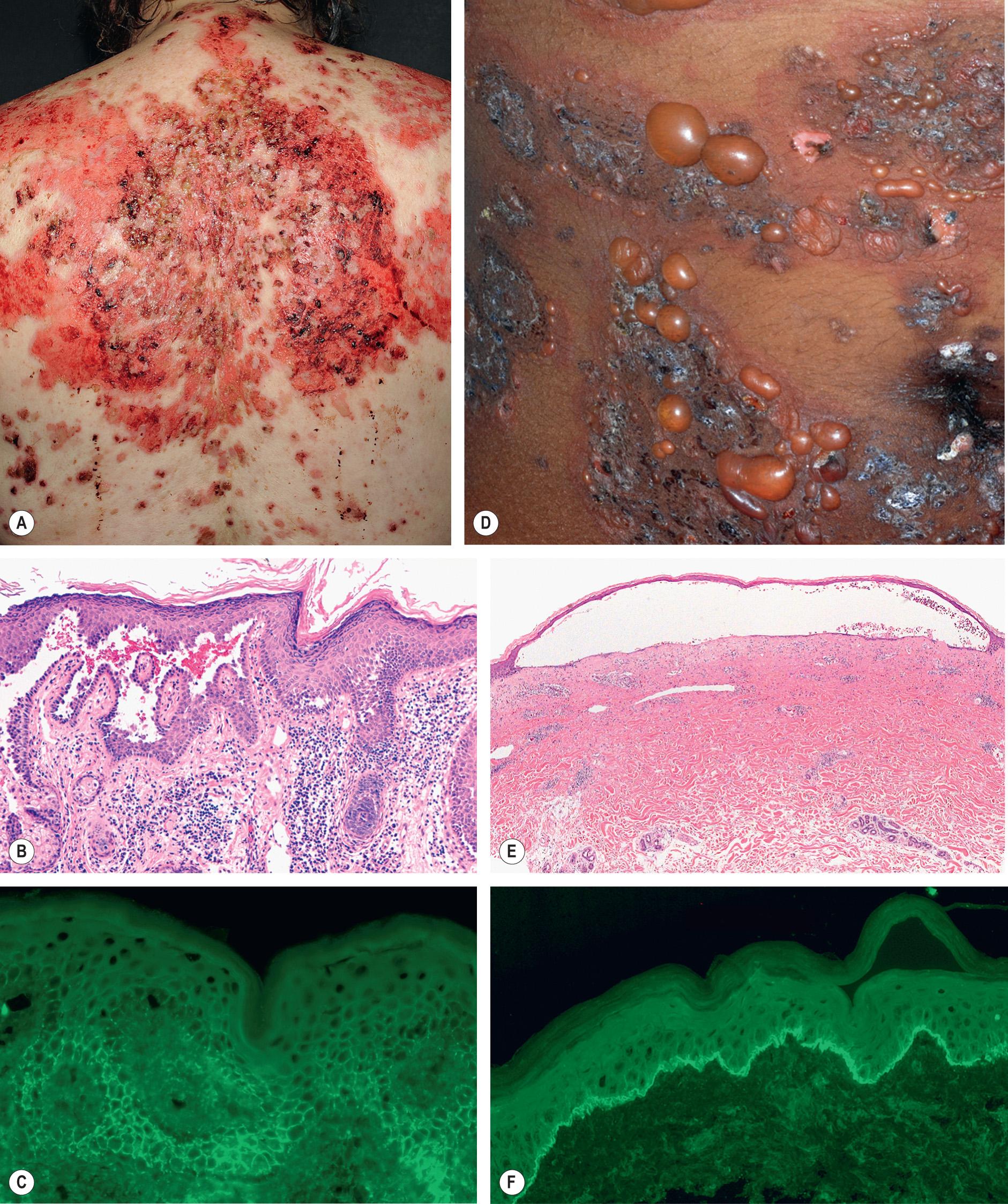
| COMMON AUTOIMMUNE SKIN DISEASES | ||
|---|---|---|
| Target antigen | Chapter | |
| Diseases with identified autoantigens | ||
| Pemphigus foliaceus | Desmoglein 1 | 29 |
| Pemphigus vulgaris ( Fig. 1.9A ) | Desmoglein 3 and 1 | 29 |
| Bullous pemphigoid ( Fig. 1.9D ) | Collagen XVII (BPAG2), BPAG1 * | 30 |
| Epidermolysis bullosa acquisita | Collagen VII | 30 |
| Dermatitis herpetiformis | Transglutaminase-3 | 31 |
| Diseases with unknown or multiple autoantigens | ||
| Subacute cutaneous lupus erythematosus | Unknown, possibly SSA/Ro | 41 |
| Chronic cutaneous lupus erythematosus | Unknown | 41 |
| Psoriasis | Unknown | 8 |
We know a substantial amount about molecular targets in these diseases, and we also know much about how immunity works in protecting against infectious diseases. However, we continue to learn about skin structure by observing disease states in which errors in recognition lead to immune responses that target “self” antigens inappropriately and damage residential structures. For example, in pemphigus vulgaris, autoantibodies directed against desmogleins compromise intercellular adhesion, leading to intraepithelial acantholysis and widespread erosions (see Fig. 1.9 ). It has also become apparent that autoimmunity directed against cutaneous antigens may impact other organ systems. For example, in patients with bullous pemphigoid and concomitant neurologic disease, circulating anti-basement membrane antibodies were found to recognize antigens in both the skin and brain .
Data to support the concept that immune responses also protect against malignancy are strongest for those malignancies that arise in skin and lymphatic tissues , especially cutaneous SCC, Merkel cell carcinoma, and melanoma. Cutaneous SCC is a well-known and relatively common complication of immunosuppression in solid organ transplant recipients . Many recent developments in melanoma therapy are based on attempts to enhance immune responsiveness ( Ch. 113 ).
From the outset, the most obvious function of skin is to maintain a barrier that prevents the loss of fluids, electrolytes, and other molecules from within the body and, at the same time, prevents penetration by microorganisms, toxic materials, and UV radiation ( Ch. 86 ). For all but UV radiation, the stratum corneum is the central element in that function. By contrast, protection against UV radiation occurs through several independent phenomena, including photon scattering in the stratum corneum and photon absorption by underlying melanin.
Become a Clinical Tree membership for Full access and enjoy Unlimited articles
If you are a member. Log in here